
Dynastinae or rhinoceros beetles are a subfamily of the scarab beetle family (Scarabaeidae). Other common names – some for particular groups of rhinoceros beetles – include Hercules beetles, unicorn beetles or horn beetles. Over 1500 species and 225 genera of rhinoceros beetles are known.

Dimethoate is a widely used organophosphate insecticide and acaricide. It was patented and introduced in the 1950s by American Cyanamid. Like other organophosphates, dimethoate is an acetylcholinesterase inhibitor which disables cholinesterase, an enzyme essential for central nervous system function. It acts both by contact and through ingestion. It is readily absorbed and distributed throughout plant tissues, and is degraded relatively rapidly.

Nudiviruses are a family of animal viruses that constitute the family Nudiviridae. Insects and marine crustaceans serve as natural hosts. There are 11 species in this family, assigned to 4 genera. Diseases associated with this family include: death in larvae, chronic disease in adults.

Xylotrupes ulysses, common names "elephant beetle", "coconut palm beetle", "common rhinoceros beetle" or simply "rhinoceros beetle" is a species of rhinoceros beetle native to New Guinea. Male horns in several groups of this genus represent a special secondary sex characteristic. There is a bimodal horn-size distribution and there is a discrete male mating behavior correlated with each phenotype.

Xylotrupes gideon, the brown rhinoceros beetle, is a species of large scarab beetle belonging to the subfamily Dynastinae.
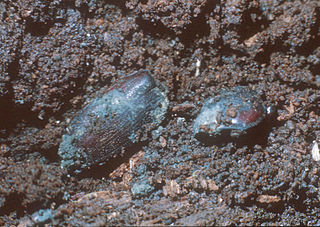
Metarhizium majus is the name given to a group of fungal isolates that are known to be virulent against Scarabaeidae, a family of beetles. Previously, this species has had variety status in Metarhizium anisopliae and its name is derived from characteristically very large spores for the genus Metarhizium. There has been considerable interest in developing isolates of this species into mycoinsecticides: especially for coconut and oil palm beetle pests in SE Asia, the Pacific region and Africa.

Tirathaba rufivena, the coconut spike moth, greater coconut spike moth or oil palm bunch moth, is a moth of the family Pyralidae. It is found from south-east Asia to the Pacific islands, including Malaysia, the Cook Islands, the Philippines and the tropical region of Queensland, Australia. They are considered as a minor pest.
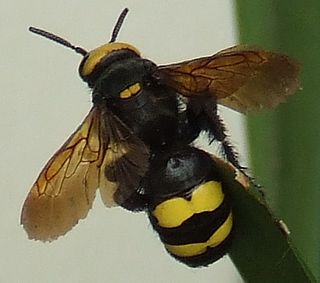
The mammoth wasp is a very large wasp, with the female reaching up to 6 centimetres (2.4 in), whereas the male is smaller. The species can be seen in warm weather, from May to September.

The Asiatic rhinoceros beetle, coconut rhinoceros beetle or coconut palm rhinoceros beetle, is a species of rhinoceros beetle of the family Scarabaeidae. O. rhinoceros attacks the developing fronds of raffia, coconut, oil, and other palms in tropical Asia and a number of Pacific islands. Damaged fronds show typical triangular cuts. The beetle kills the palms when the growing point is destroyed during feeding. They also infest dead trunk debris.

Oryctes is the most economically important genus of rhinoceros beetles in the subfamily Dynastinae, since it includes a notorious insect pest of palms.
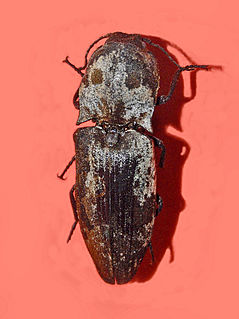
Calais is a genus of click beetle belonging to the family Elateridae and the subfamily Agrypninae.
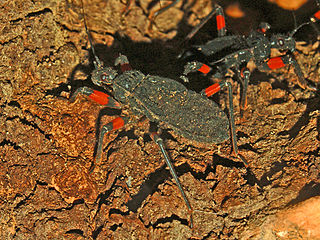
Platymeris rhadamanthus, the red spot assassin bug, is a species of true bugs belonging to the family Reduviidae.
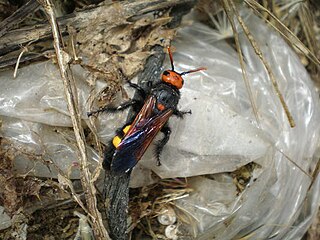
Megascolia is a genus of large solitary wasps from the family Scoliidae, the species classified under Megascolia include some of the world's largest wasps. They are parasitoids of large Scarabeid beetles such as the European rhinoceros beetle Oryctes nasicornis and Atlas beetle Chalcosoma atlas.
Macroplectra nararia, the coconut slug caterpillar, is a moth of the family Limacodidae. The species was first described by Frederic Moore in 1859. It is found in Sri Lanka and India.

Oryctini is a tribe of beetles in the Dynastinae.
As with a number of other geographically isolated islands, Guam has problems with invasive species negatively affecting the natural biodiversity of the island.

Digitonthophagus bonasus, is a species of dung beetle found in India, Sri Lanka, Pakistan, Nepal, Myanmar, Thailand, Afghanistan, Vietnam and Cambodia.
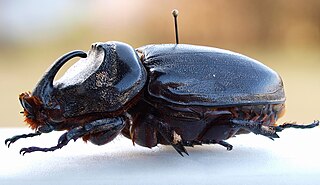
Oryctes gnu, commonly known as Malaysian rhinoceros beetle, is a species of dung beetle native to South Asian and South East Asian countries including: India, Pakistan, Sri Lanka, Philippines, Thailand, Philippines, and Vietnam. It is also introduced to many parts of the world.















